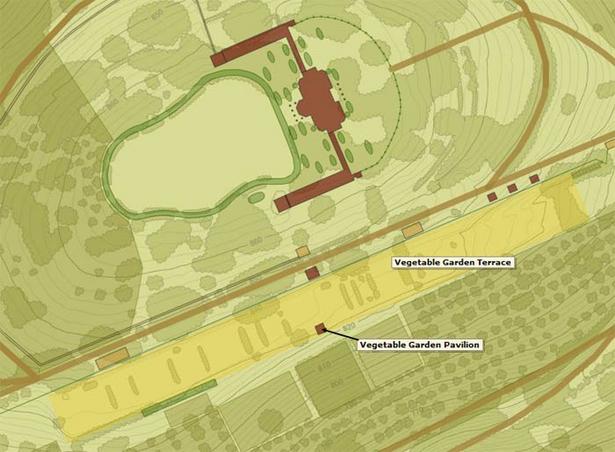The vegetable garden evolved over many years, beginning in 1770 when crops were first cultivated along the contours of the slope. Terracing was introduced in 1806, and by 1812, gardening activity was at its peak. The 1,000-foot-long terrace, or garden plateau, was literally hewed from the side of the mountain with slave labor, and it was supported by a massive stone wall that stood over twelve feet in its highest section. One contemporary visitor remarked on the dramatic "sea view" across the rolling Piedmont countryside.
Perched atop the wall, at the half-way point of the garden, is the garden pavilion with its double-sash windows, Chinese railing, and pyramidal roof. The pavilion was used by Jefferson as a quiet retreat where he could read in the evening. It was reputedly blown down in a violent wind storm in the late 1820's. The pavilion was reconstructed in 1984 based on Jefferson's notes and archaeological excavations. It overlooks an eight-acre orchard of 300 trees, a vineyard, and Monticello's berry squares, which are plots of figs, currants, gooseberries, and raspberries.
The main part of the two-acre garden is divided into twenty-four "squares," or growing plots, and at least in 1812, the squares were arranged according to which part of the plant was being harvested -- whether "fruits" (tomatoes, beans), "roots" (beets, carrots), or "leaves" (lettuce, cabbage). Jefferson used the Northwest Border to plant peas very early in the season, and this should have provided a clear advantage in the annual neighborhood pea contests -- whoever brought the first English pea to table would host a dinner that included the winning dish of peas. At the base of the wall, below the garden, Jefferson successfully grew figs in "submural beds," which were also situated to create a uniquely warm setting.

The site and situation of the garden enabled Jefferson to extend the growing season into the winter months and provided an amenable microclimate for tender vegetables such as the French artichoke. The garden, as well as the orchard, was surrounded by a ten-foot-high wooden or "paling" fence, which ran for nearly three-quarters of a mile. While the fence was constructed primarily as a defense against domestic animals and deer, the boards were placed "so near as not to let even a young hare in."
